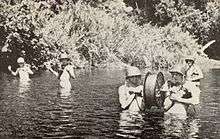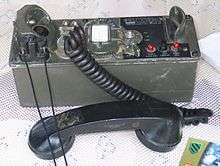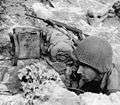Field telephone
Field telephones are telephones used for military communications. They can draw power from their own battery, from a telephone exchange (via a central battery known as CB), or from an external power source. Some need no battery, being sound-powered telephones.


Field telephones replaced flag signals and the telegraph as an efficient means of communication. The first field telephones had a wind-up generator, used to power the telephone's ringer & batteries to send the call, and call the manually operated telephone central. This technology was used from the 1910s to the 1960s. Later the ring signal has been made electronically operated by a pushbutton, or automatic as on domestic telephones. The manual systems are still widely used, and are often compatible with the older equipment.
Shortly after the invention of the telephone attempts were made to adapt the technology for military use. Telephones were already being used to support military campaigns in British India and in British colonies in Africa in the late 1870s and early 1880s. In the United States telephone lines connected fortresses with each other and with army headquarters. They were also used for fire control at fixed coastal defence installations. The first telephone for use in the field was developed in the United States in 1889 but it was too expensive for mass production. Subsequent developments in several countries made the field telephone more practicable. The wire material was changed from iron to copper, devices for laying wire in the field were developed and systems with both battery-operated sets for command posts and hand generator sets for use in the field were developed. The first purposely-designed field telephones were used by the British in the Second Boer War.[1] They were used more extensively in the Russo-Japanese War, where all infantry regiments and artillery divisions on both sides were equipped with telephone sets.[2] By the First World War the use of field telephones was widespread.[3]
Field telephones operate over wire lines, sometimes commandeering civilian circuits when available, but often using wires strung in combat conditions.[4] At least as of World War II, wire communications were the preferred method for the U.S. Army, with radio use only when needed, e.g. to communicate with mobile units, or until wires could be set up. Field phones could operate point to point or via a switchboard at a command post.[5] A variety of wire types are used, ranging from light weight "assault wire", e.g. W-130 —8.5 kilograms per kilometre (30 pounds per mile)— with a talking range about 8.0 kilometres (5 mi), to heavier cable with multiple pairs. Equipment for laying the wire ranges from reels on backpacks to trucks equipped with plows to bury lines.[6]
Field telephones used by the United States Army
 Soldier uses an EE-8 field telephone
Soldier uses an EE-8 field telephone TA-312 field telephone
TA-312 field telephone- TA-312 with handset off hook
 Telephone Set TA-312 Manual
Telephone Set TA-312 Manual- Field telephone switchboard on display at the Fort Devens Museum
- EE-8, World War II era through Vietnam War.[7]
- TA-1 4 mile range self powered no batteries
- TA-43
- TA-312[8]
- TA-838,[9] includes touch-tone key pad.
Torture of POWs
According to the Army's Vietnam War Crimes Working Group Files, field telephones were sometimes used in Vietnam to torture POWs with electric shocks during interrogations.[10]
Field telephones of the Soviet Union
 Russian УНА field telephone
Russian УНА field telephone Russian ТАИ-43 field telephone
Russian ТАИ-43 field telephone- Russian TA-57 field telephone
- УНА "Unified unit" (Унифицированный аппарат)
- ТАИ-43 field telephone set (Полевой Телефонный Аппарат)
- ТА-57 field telephone set (Полевой Телефонный Аппарат)
Field telephones used by the Royal Norwegian Defence Forces
 L.M. Ericsson M37 field telephone
L.M. Ericsson M37 field telephone
- TP-6N Developed in Norway for the armed forces early 1970s.
- TP-6NA Versions of TP-6N A to C
- M37 Swedish field telephone used by the Norwegian Civil Defence. This phone is fully interoperable with the EE-8, TA-1, TA-43 and TA-312 series of US Field Phones.
- EE-8 A part of The Marshall Plan (from its enactment, officially the European Recovery Program, ERP) The EE-8* was used in USA from World War II to late seventies, and in Norway from World War II until the TP-6 could replace it.
- FF33 This phone was widely used from mid 1950s until it was replaced by TP-6 (after the EE-8) FF33 was left by the Germans when World War II ended, but was not used immediately due to political reasons.
- Mod 1932 Developed by Elektrisk Bureau for the Norwegian forces, approved in 1932 (as the 1st std. field telephone), but never made in great numbers, due to bureaucracy and the start of World War II. Based on a model made for the Turkish Army by Elektrisk Burau.
Field telephones used by the Finnish Defence Forces
 P 78 field telephone
P 78 field telephone- P 90 field telephone
- TA-57, made in the Soviet Union
- P78, made in Sweden by L.M. Ericsson
- P90, made in the UK by Racal Acoustics Ltd.
- ET-10, made by Terma A/S
Field telephones used by the German Defence Forces
- FF33
 FF OB/ZB
FF OB/ZB- SFT800
- FF33
- FF OB/ZB
- SFT800
References
- Sterling, Christopher H.; Military Communications: From Ancient Times to the 21st Century (2008). Santa Barbara: ABC-CLIO. ISBN 978-1-85109-732-6 p. 444.
- Ivanov, Alexei and Philipp S. Jowett; The Russo-Japanese War 1904-1905 (2004). Oxford: Osprey Publishing. ISBN 1-84176-708-5 p. 11.
- Sterling p. 445.
- An account of line stringing in WW II
- Signal Operations in the Corps and Army, FM 11-22, U.S. War Department, January 1945
- "Wire and Cable Equipment, World War II". Archived from the original on 2013-03-07. Retrieved 2012-08-17.
- EE-8
- TA-312
- TA-838
- Deborah Nelson, “THE WAR BEHIND ME: Vietnam Veterans Confront the Truth About U.S. War Crimes” Archived July 17, 2011, at the Wayback Machine, Basic Books, ISBN 978-0-465-00527-7, October 28, 2008
External links
| Wikimedia Commons has media related to Field telephones. |
- Gordon L. Rottman (2010): "World War II Battlefield Communications (Elite)", Osprey Military, ISBN 1-84603847-2 .
- TA-312 Field Phone
- TP-6 Norwegian Field Telephone
- EE-8 Field Phone
- FF33 Field Phone
- Norwegian mod. 1932 Field Phone